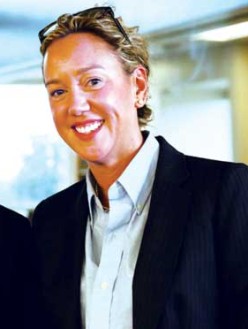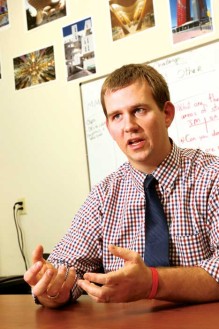As current fifth-graders contemplate, with mixed feelings, their move to middle school next year, two new principals are spending the year creating new schools, making daily decisions about curriculum, staff, rules and the very culture of the schools they will open next year. In the absence of a physical building to walk into and tour, Kristen Atwood, of the Denver Discovery School, and John Clark, of DSST: Conservatory Green, give a sense of what life will be like in their new schools.
Denver Discovery School

Kristen Atwood, principal of
Denver Discovery School
In this year of school planning, Principal Kristen Atwood is driven by being a mother of two young children who approach the world and learning in very different ways. She says that every time she adds an element into the development of the school, or interviews a teacher, she thinks about the variety of children she will have in the Denver Discovery School (DDS).
Atwood stresses that DDS will be a place where “identities will be formed and celebrated and where the true inner child is able to be heard.” She feels the relatively small size of the school will facilitate that. As an example, Atwood paints the picture of morning meetings, which will be student lead and driven. “Kids will be playing African drums, singing the school chant as everyone walks in. Four students will stand up and acknowledge their peers based on the character values they witnessed in the previous day or week in the school. So it’s really about finding ourselves and developing ourselves as leaders and having opportunities to shine,” she explains.
Strong Academics
Each student’s experience in the classroom will consist of a blend of enrichment classes and 60- minute core classes. During the core classes, Atwood says students will be fully engaged with 100 percent involvement in the classroom. Students of every level will be addressed during portions of class time where there will be opportunities to work individually, in groups and with the teacher when a little extra instruction is needed.
Creating a Love of Learning
Throughout the school year, students will have the opportunity to meet professionals currently doing what the kids are learning in school to help make the connection between school and life. Atwood feels kids are engaged when you “talk to them in their interest areas and show them this could be their gift one day. So you bring people in and fill kids’ minds with these ideas around those different topics.
Atwood also feels students will enjoy learning when they are given the structure and predictability she feels they crave while enabling them to see teachers and fellow students happy and excited about school. The school day schedule, as well, balances opportunities to express creativity, work hard, and get exercise, all things that Atwood says activate different parts of middle-schoolers’ brains.
The Right Student for the School
With three opportunities for project-based learning during the school year, Atwood says projects are a relatively small part of their curriculum. “At the end of the day, it’s really a traditional middle school that offers thematic units and culminating projects that require critical-thinking skills, problem solving and the opportunity to work collaboratively. Any child would blossom here!” She adds that students will be challenged and the curriculum will adhere to college preparatory standards. Supports will be in place for children who are struggling. “What sets us apart is that students will have the time in their day to be leaders through morning meetings, advisory, service learning and just being in a small school,” says Atwood. “It’s going to be a tightknit group.”
Denver School of Science and Technology: Conservatory Green

John Clark, principal of
DSST: Conservatory Green
DSST: Conservatory Green, led by Principal John Clark, will be the newest addition to the Denver School of Science and Technology “network.” There are variations between each school that give them their own personality, including a specific focus within the STEM curriculum. Conservatory Green’s focus will be on computer programming. However, Clark wants to provide a well-rounded education “that allows (students) to invest in different avenues in the world because the world is a more global place and it’s more important that we know a variety of things and not just one set of skills.”
“We believe that whatever you want to do with your life, wherever you want to go, that if you have confidence, if you have values at the heart of it all, you can be successful,” he says. That said, Clark says it will be “a relationship school” with students, families and the community. “That relationship is what will hold (everyone) accountable to learning so that both students and families feel confident that their child is getting an excellent education. DSST’s core belief is that we want to help you contribute and affirm what you’re doing,” says Clark.
Strong Academics
Like its sister schools, DSST: Conservatory Green will be college preparatory with what the school considers to be brain-based learning. Clark says “we believe kids learn best when they do hands-on investigation in science or applying real concepts through math problems. It’s about putting that problem in context. If you give kids essential questions that are challenging, they’ll have to use the knowledge they’ve been given to figure it out. It’s about how do you go deep with your knowledge to solve problems.”
Creating a Love of Learning
To engage students, Clark says teachers will always be open and honest with them about why the things they are learning are important. “I think we do a great job of teaching our staff it’s as much about the ‘why’ as the ‘what.’” Students will be encouraged to connect what they are learning with future careers by connecting with a yet-to-be-determined local university based in computer programming and by bringing in members of the community to speak.
The Right Student for the School
The DSST schools have the reputation of being challenging both academically and in terms of rules. However, Clark feels the school will be a good fit for any student, regardless of their academic level. “We don’t teach to a set curriculum that we live and die by,” says Clark. “We meet kids where they are to help them reach the standards they need to meet to succeed.” He cites opportunities to work with teachers on a voluntary or mandatory basis as an example. “Every kid can learn at our school and every kid can succeed.”
Rules such as no talking in the hallways between classes and a required uniform are an adjustment for kids and parents at first. Clark defends the concepts saying that silent hallways give the teachers and students time to get ready for class without the distraction of “gossiping and note-passing where the cruel behaviors can happen.” And he feels uniforms help both the students and teachers focus on what’s going on in the classroom. “It’s easier for kids. It’s one less thing for them to worry about, and it’s a great equalizer.”




0 Comments